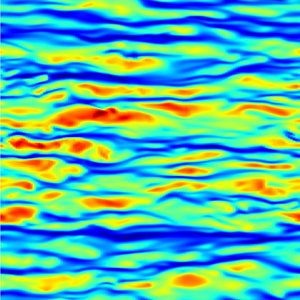Article contents
Near-wall patch representation of wall-bounded turbulence
Published online by Cambridge University Press: 28 September 2020
Abstract

Recent experimental and computational studies indicate that near-wall turbulent flows can be characterized by universal small-scale autonomous dynamics that is modulated by large-scale structures. We formulate numerical simulations of near-wall turbulence in a small domain localized to the boundary, whose size scales in viscous units. To mimic the environment in which the near-wall turbulence evolves, the formulation accounts for the flux of mean momentum through the upper boundary of the domain. Comparisons of the model's two-dimensional energy spectra and low-order single-point statistics with the corresponding quantities computed from direct numerical simulations indicate that it successfully captures the dynamics of the small-scale near-wall turbulence.
Information
- Type
- JFM Papers
- Information
- Copyright
- © The Author(s), 2020. Published by Cambridge University Press
References
REFERENCES
- 10
- Cited by


